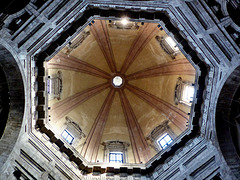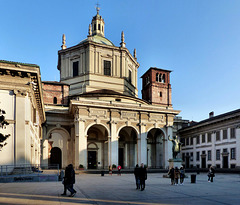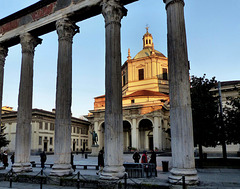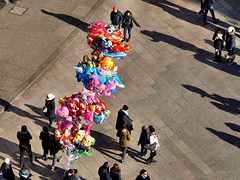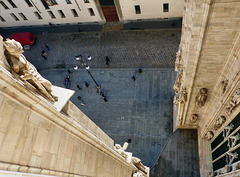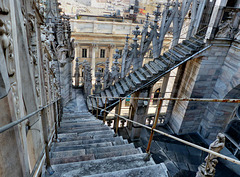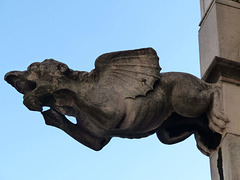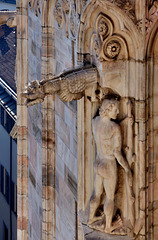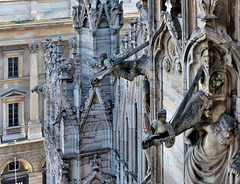Martin M. Miles' photos
Milan - Basilica di San Lorenzo
| |
|
Milan is the city capital of the Lombardy and the second most populous city in Italy after Rome. Known during Roman times as "Mediolanum" it was the place, where in 313 Constantine I and Licinius met and "signed" the "Edict of Milan", giving Christianity a legal status within the Roman empire.
At the end of the Roman empire Milan was besieged by the Visigoths in 402, looted by the Huns in 452, and taken by the Ostrogoths in 539. Only 30 years later is belonged to the Kingdom of the Lombards, until in 774 Charlemagne defeated the Langobards and added Milan to the Carolingian empire. During Barbarossa´s (Frederik I) "Italian Campaigns" Milan was taken and destroyed to a great extent.
Milan came back and flourished, when in 1386 the construction of the cathedral began, the Basilica di San Lorenzo had survived about a 1000 years! It was built between the late 4th and early 5th centuries. Some scholars connect it to (Arian!) bishop Auxentius (355-372) others to Flavius Stilicho (359 – 408) a powerful "magister militum" in the Roman army and close relative of Thedodosius I.
Desasters like fires and earthquakes have hitten the Basilica different times, but it got rebuilt, renovated, reconstructed and of course altered may times. Today the Basilica di San Lorenzo is a "complex" of churches and chapels.
The central structure is a squarish tetraconch with four apses, one in each direction. The chapels radiate from the ambulatory.
In 1573 the dome of the basilica collapsed. Construction of a new octagonal dome began immediately and was completed in 1619.
On the columns of the ambulatory are frescoes from different times.
Milan - Basilica di San Lorenzo
| |
|
Milan is the city capital of the Lombardy and the second most populous city in Italy after Rome. Known during Roman times as "Mediolanum" it was the place, where in 313 Constantine I and Licinius met and "signed" the "Edict of Milan", giving Christianity a legal status within the Roman empire.
At the end of the Roman empire Milan was besieged by the Visigoths in 402, looted by the Huns in 452, and taken by the Ostrogoths in 539. Only 30 years later is belonged to the Kingdom of the Lombards, until in 774 Charlemagne defeated the Langobards and added Milan to the Carolingian empire. During Barbarossa´s (Frederik I) "Italian Campaigns" Milan was taken and destroyed to a great extent.
Milan came back and flourished, when in 1386 the construction of the cathedral began, the Basilica di San Lorenzo had survived about a 1000 years! It was built between the late 4th and early 5th centuries. Some scholars connect it to (Arian!) bishop Auxentius (355-372) others to Flavius Stilicho (359 – 408) a powerful "magister militum" in the Roman army and close relative of Thedodosius I.
Desasters like fires and earthquakes have hitten the Basilica different times, but it got rebuilt, renovated, reconstructed and of course altered may times. Today the Basilica di San Lorenzo is a "complex" of churches and chapels.
The central structure is a squarish tetraconch with four apses, one in each direction. The chapels radiate from the ambulatory.
In 1573 the dome of the basilica collapsed. Construction of a new octagonal dome, seen here, began immediately and was completed in 1619.
Milan - Basilica di San Lorenzo
| |
|
Milan is the city capital of the Lombardy and the second most populous city in Italy after Rome. Known during Roman times as "Mediolanum" it was the place, where in 313 Constantine I and Licinius met and "signed" the "Edict of Milan", giving Christianity a legal status within the Roman empire.
At the end of the Roman empire Milan was besieged by the Visigoths in 402, looted by the Huns in 452, and taken by the Ostrogoths in 539. Only 30 years later is belonged to the Kingdom of the Lombards, until in 774 Charlemagne defeated the Langobards and added Milan to the Carolingian empire. During Barbarossa´s (Frederik I) "Italian Campaigns" Milan was taken and destroyed to a great extent.
Milan came back and flourished, when in 1386 the construction of the cathedral began, the Basilica di San Lorenzo had survived about a 1000 years! It was built between the late 4th and early 5th centuries. Some scholars connect it to (Arian!) bishop Auxentius (355-372) others to Flavius Stilicho (359 – 408) a powerful "magister militum" in the Roman army and close relative of Thedodosius I.
Desasters like fires and earthquakes have hitten the Basilica different times, but it got rebuilt, renovated, reconstructed and of course altered may times. Today the Basilica di San Lorenzo is a "complex" of churches and chapels.
The central structure is a squarish tetraconch with four apses, one in each direction. The chapels radiate from the ambulatory.
In 1573 the dome of the basilica collapsed. Construction of a new dome in a more modern style began immediately and was completed in 1619.
Milan - Basilica di San Lorenzo
| |
|
Milan is the city capital of the Lombardy and the second most populous city in Italy after Rome. Known during Roman times as "Mediolanum" it was the place, where in 313 Constantine I and Licinius met and "signed" the "Edict of Milan", giving Christianity a legal status within the Roman empire.
At the end of the Roman empire Milan was besieged by the Visigoths in 402, looted by the Huns in 452, and taken by the Ostrogoths in 539. Only 30 years later is belonged to the Kingdom of the Lombards, until in 774 Charlemagne defeated the Langobards and added Milan to the Carolingian empire. During Barbarossa´s (Frederik I) "Italian Campaigns" Milan was taken and destroyed to a great extent.
Milan came back and flourished, when in 1386 the construction of the cathedral began, the Basilica di San Lorenzo had survived about a 1000 years! It was built between the late 4th and early 5th centuries. Some scholars connect it to (Arian!) bishop Auxentius (355-372) others to Flavius Stilicho (359 – 408) a powerful "magister militum" in the Roman army and close relative of Thedodosius I.
Desasters like fires and earthquakes have hitten the Basilica different times, but it got rebuilt, renovated, reconstructed and of course altered may times. Today the Basilica di San Lorenzo is a "complex " of churches and chapels.
The building in the center is a tetraconch with four apses, one in each direction. In 1573 the dome of the basilica collapsed. Construction of a new dome in a more modern style began immediately and were completed in 1619.
The three arches of the vestibule were added in 1894.
Milan - Basilica di San Lorenzo
| |
|
|
|
Milan is the city capital of the Lombardy and the second most populous city in Italy after Rome. Known during Roman times as "Mediolanum" it was the place, where in 313 Constantine I and Licinius met and "signed" the "Edict of Milan", giving Christianity a legal status within the Roman empire.
At the end of the Roman empire Milan was besieged by the Visigoths in 402, looted by the Huns in 452, and taken by the Ostrogoths in 539. Only 30 years later is belonged to the Kingdom of the Lombards, until in 774 Charlemagne defeated the Langobards and added Milan to the Carolingian empire. During Barbarossa´s (Frederik I) "Italian Campaigns" Milan was taken and destroyed to a great extent.
Milan came back and flourished, when in 1386 the construction of the cathedral began, the Basilica di San Lorenzo had survived about a 1000 years! It was built between the late 4th and early 5th centuries. Some scholars connect it to (Arian!) bishop Auxentius (355-372) others to Flavius Stilicho (359 – 408) a powerful "magister militum" in the Roman army and close relative of Thedodosius I.
Desasters like fires and earthquakes have hitten the Basilica different times, but it got rebuilt, renovated, reconstructed and of course altered may times. Today the Basilica di San Lorenzo is a "complex " of churches and chapels.
Located in front of the Basilica of San Lorenzo is the "Colonne di San Lorenzo" consisting out of 16 tall Roman columns, that were moved here
from 2nd century temple or public bath house.
A statue of Constantine I is in the in the center of the square. He may have agreed to the "Edict of Milan" right here.
Milan - Basilica di San Lorenzo
| |
|
Milan is the city capital of the Lombardy and the second most populous city in Italy after Rome. Known during Roman times as "Mediolanum" it was the place, where in 313 Constantine I and Licinius met and "signed" the "Edict of Milan", giving Christianity a legal status within the Roman empire.
At the end of the Roman empire Milan was besieged by the Visigoths in 402, looted by the Huns in 452, and taken by the Ostrogoths in 539. Only 30 years later is belonged to the Kingdom of the Lombards, until in 774 Charlemagne defeated the Langobards and added Milan to the Carolingian empire. During Barbarossa´s (Frederik I) "Italian Campaigns" Milan was taken and destroyed to a great extent.
Milan came back and flourished, when in 1386 the construction of the cathedral began, the Basilica di San Lorenzo had survived about a 1000 years! It was built between the late 4th and early 5th centuries. Some scholars connect it to (Arian!) bishop Auxentius (355-372) others to Flavius Stilicho (359 – 408) a powerful "magister militum" in the Roman army and close relative of Thedodosius I.
Desasters like fires and earthquakes have hitten the Basilica different times, but it got rebuilt, renovated, reconstructed and of course altered may times. Today the Basilica di San Lorenzo is a "complex " of churches and chapels.
The octagonal baptistery "Cappella di Sant'Aquilino" is dated to the 4th/5th centuries.
Milan - Basilica di San Lorenzo
| |
|
|
|
Milan is the city capital of the Lombardy and the second most populous city in Italy after Rome. Known during Roman times as "Mediolanum" it was the place, where in 313 Constantine I and Licinius met and "signed" the "Edict of Milan", giving Christianity a legal status within the Roman empire.
At the end of the Roman empire Milan was besieged by the Visigoths in 402, looted by the Huns in 452, and taken by the Ostrogoths in 539. Only 30 years later is belonged to the Kingdom of the Lombards, until in 774 Charlemagne defeated the Langobards and added Milan to the Carolingian empire. During Barbarossa´s (Frederik I) "Italian Campaigns" Milan was taken and destroyed to a great extent.
Milan came back and flourished, when in 1386 the construction of the cathedral began, the Basilica di San Lorenzo had survived about a 1000 years! It was built between the late 4th and early 5th centuries. Some scholars connect it to (Arian!) bishop Auxentius (355-372) others to Flavius Stilicho (359 – 408) a powerful "magister militum" in the Roman army and close relative of Thedodosius I.
Desasters like fires and earthquakes have hitten the Basilica different times, but it got rebuilt, renovated, reconstructed and of course altered may times. Today the Basilica di San Lorenzo is a "complex " of churches and chapels.
Here, seen from southeast, is to the left the octagonal baptistery (4th/5th century).
Milan - Galleria Vittorio Emanuele II
| |
|
|
Milan is the city capital of the Lombardy and the second most populous city in Italy after Rome. Known during Roman times as "Mediolanum" it was the place, where in 313 Constantine I and Licinius met and "signed" the "Edict of Milan", giving Christianity a legal status within the Roman empire.
At the end of the Roman empire Milan was besieged by the Visigoths in 402, looted by the Huns in 452, and taken by the Ostrogoths in 539. Only 30 years later is belonged to the Kingdom of the Lombards, until in 774 Charlemagne defeated the Langobards and added Milan to the Carolingian empire. During Barbarossa´s (Frederik I) "Italian Campaigns" Milan was taken and destroyed to a great extent.
Milan came back and flourished, when in 1386 the construction of the cathedral began. It took centuries to complete. In 1805, Napoleon Bonaparte, about to be crowned King of Italy here, ordered the façade to be finished in 1813.
The "Duomo di Milano" is surrounded by the "Piazza del Duomo". The most prominent building (next to the Duomo) is the "Galleria Vittorio Emanuele II" with its triumphal arch. It is the world´s oldest shopping mall, named after Victor Emmanuel II, the first king of the Kingdom of Italy, and built by Giuseppe Mengoni 1865 - 1877.
The structure consists of two glass-vaulted arcades intersecting in an octagonal space, that is topped with a glass dome.
Milan - Piazza del Duomo
| |
|
Milan is the city capital of the Lombardy and the second most populous city in Italy after Rome. Known during Roman times as "Mediolanum" it was the place, where in 313 Constantine I and Licinius met and "signed" the "Edict of Milan", giving Christianity a legal status within the Roman empire.
At the end of the Roman empire Milan was besieged by the Visigoths in 402, looted by the Huns in 452, and taken by the Ostrogoths in 539. Only 30 years later is belonged to the Kingdom of the Lombards, until in 774 Charlemagne defeated the Langobards and added Milan to the Carolingian empire. During Barbarossa´s (Frederik I) "Italian Campaigns" Milan was taken and destroyed to a great extent.
Milan came back and flourished, when in 1386 Archbishop Antonio da Saluzzo began construction of the cathedral. The construction program was strictly regulated under the "Fabbrica del Duomo", which had 300 employees led by a chief engineer. The first of these chief engineers, Simone da Orsenigo, planned to build the cathedral from brick in Lombard Gothic style. Three years later French chief engineer Nicolas de Bonaventure decided that the brick structure should be panelled with marble.
Apse and transepts were completed in 1409, the crossing tower in 1500. When in 1572 the Duomo de Milano got finally consecrated by Archbishop Carlo Borromeo, the facade was not completed. There were different designs, but none was ever finished.
Work slowed down until until in 1805, Napoleon Bonaparte, about to be crowned King of Italy here, ordered the façade to be finished. It got completed in neo Gothic style in 1813.
With an interior area of 11700m² the "Duomo di Milano" is the world´s third largest church and one of the few (I know), where the roof is open to tourists. The day I was up the roof was icy - and so the tourists were only allowed to the galery to see the pinnacles, spires, sculptures and the delicate flying buttresses - and all the people walking the Piazza del Duomo.
Milan - Duomo di Milano
| |
|
Milan is the city capital of the Lombardy and the second most populous city in Italy after Rome. Known during Roman times as "Mediolanum" it was the place, where in 313 Constantine I and Licinius met and "signed" the "Edict of Milan", giving Christianity a legal status within the Roman empire.
At the end of the Roman empire Milan was besieged by the Visigoths in 402, looted by the Huns in 452, and taken by the Ostrogoths in 539. Only 30 years later is belonged to the Kingdom of the Lombards, until in 774 Charlemagne defeated the Langobards and added Milan to the Carolingian empire. During Barbarossa´s (Frederik I) "Italian Campaigns" Milan was taken and destroyed to a great extent.
Milan came back and flourished, when in 1386 Archbishop Antonio da Saluzzo began construction of the cathedral. The construction program was strictly regulated under the "Fabbrica del Duomo", which had 300 employees led by a chief engineer. The first of these chief engineers, Simone da Orsenigo, planned to build the cathedral from brick in Lombard Gothic style. Three years later French chief engineer Nicolas de Bonaventure decided that the brick structure should be panelled with marble.
Apse and transepts were completed in 1409, the crossing tower in 1500. When in 1572 the Duomo de Milano got finally consecrated by Archbishop Carlo Borromeo, the facade was not completed. There were different designs, but none was ever finished.
Work slowed down until until in 1805, Napoleon Bonaparte, about to be crowned King of Italy here, ordered the façade to be finished. It got completed in neo Gothic style in 1813.
With an interior area of 11700m² the "Duomo di Milano" is the world´s third largest church and one of the few (I know), where the roof is open to tourists. The day I was up the roof was icy - and so the tourists were only allowed to the galery to see the pinnacles, spires, sculptures and the delicate flying buttresses.
Milan - Duomo di Milano
| |
|
Milan is the city capital of the Lombardy and the second most populous city in Italy after Rome. Known during Roman times as "Mediolanum" it was the place, where in 313 Constantine I and Licinius met and "signed" the "Edict of Milan", giving Christianity a legal status within the Roman empire.
At the end of the Roman empire Milan was besieged by the Visigoths in 402, looted by the Huns in 452, and taken by the Ostrogoths in 539. Only 30 years later is belonged to the Kingdom of the Lombards, until in 774 Charlemagne defeated the Langobards and added Milan to the Carolingian empire. During Barbarossa´s (Frederik I) "Italian Campaigns" Milan was taken and destroyed to a great extent.
Milan came back and flourished, when in 1386 Archbishop Antonio da Saluzzo began construction of the cathedral. The construction program was strictly regulated under the "Fabbrica del Duomo", which had 300 employees led by a chief engineer. The first of these chief engineers, Simone da Orsenigo, planned to build the cathedral from brick in Lombard Gothic style. Three years later French chief engineer Nicolas de Bonaventure decided that the brick structure should be panelled with marble.
Apse and transepts were completed in 1409, the crossing tower in 1500. When in 1572 the Duomo de Milano got finally consecrated by Archbishop Carlo Borromeo, the facade was not completed. There were different designs, but none was ever finished.
Work slowed down until until in 1805, Napoleon Bonaparte, about to be crowned King of Italy here, ordered the façade to be finished. It got completed in neo Gothic style in 1813.
With an interior area of 11700m² the "Duomo di Milano" is the world´s third largest church and one of the few (I know), where the roof is open to tourists. The day I was up the roof was icy - and so the tourists were only allowed to the galery to see the pinnacles, spires, sculptures and the delicate flying buttresses.
Milan - Duomo di Milano
| |
|
|
Milan is the city capital of the Lombardy and the second most populous city in Italy after Rome. Known during Roman times as "Mediolanum" it was the place, where in 313 Constantine I and Licinius met and "signed" the "Edict of Milan", giving Christianity a legal status within the Roman empire.
At the end of the Roman empire Milan was besieged by the Visigoths in 402, looted by the Huns in 452, and taken by the Ostrogoths in 539. Only 30 years later is belonged to the Kingdom of the Lombards, until in 774 Charlemagne defeated the Langobards and added Milan to the Carolingian empire. During Barbarossa´s (Frederik I) "Italian Campaigns" Milan was taken and destroyed to a great extent.
Milan came back and flourished, when in 1386 Archbishop Antonio da Saluzzo began construction of the cathedral. The construction program was strictly regulated under the "Fabbrica del Duomo", which had 300 employees led by a chief engineer. The first of these chief engineers, Simone da Orsenigo, planned to build the cathedral from brick in Lombard Gothic style. Three years later French chief engineer Nicolas de Bonaventure decided that the brick structure should be panelled with marble.
Apse and transepts were completed in 1409, the crossing tower in 1500. When in 1572 the Duomo de Milano got finally consecrated by Archbishop Carlo Borromeo, the facade was not completed. There were different designs, but none was ever finished.
Work slowed down until until in 1805, Napoleon Bonaparte, about to be crowned King of Italy here, ordered the façade to be finished. It got completed in neo Gothic style in 1813.
With an interior area of 11700m² the "Duomo di Milano" is the world´s third largest church and one of the few (I know), where the roof is open to tourists. The day I was up the roof was icy - and so the tourists were only allowed to the galery to see the pinnacles, spires, sculptures and the delicate flying buttresses.
Milan - Duomo di Milano
| |
|
Milan is the city capital of the Lombardy and the second most populous city in Italy after Rome. Known during Roman times as "Mediolanum" it was the place, where in 313 Constantine I and Licinius met and "signed" the "Edict of Milan", giving Christianity a legal status within the Roman empire.
At the end of the Roman empire Milan was besieged by the Visigoths in 402, looted by the Huns in 452, and taken by the Ostrogoths in 539. Only 30 years later is belonged to the Kingdom of the Lombards, until in 774 Charlemagne defeated the Langobards and added Milan to the Carolingian empire. During Barbarossa´s (Frederik I) "Italian Campaigns" Milan was taken and destroyed to a great extent.
Milan came back and flourished, when in 1386 Archbishop Antonio da Saluzzo began construction of the cathedral. The construction program was strictly regulated under the "Fabbrica del Duomo", which had 300 employees led by a chief engineer. The first of these chief engineers, Simone da Orsenigo, planned to build the cathedral from brick in Lombard Gothic style. Three years later French chief engineer Nicolas de Bonaventure decided that the brick structure should be panelled with marble.
Apse and transepts were completed in 1409, the crossing tower in 1500. When in 1572 the Duomo de Milano got finally consecrated by Archbishop Carlo Borromeo, the facade was not completed. There were different designs, but none was ever finished.
Work slowed down until until in 1805, Napoleon Bonaparte, about to be crowned King of Italy here, ordered the façade to be finished. It got completed in neo Gothic style in 1813.
With an interior area of 11700m² the "Duomo di Milano" is the world´s third largest church and one of the few (I know), where the roof is open to tourists. The day I was up the roof was icy - and so the tourists were only allowed to the galery to see the pinnacles, spires, sculptures and the delicate flying buttresses.
Milan - Duomo di Milano
| |
|
Milan is the city capital of the Lombardy and the second most populous city in Italy after Rome. Known during Roman times as "Mediolanum" it was the place, where in 313 Constantine I and Licinius met and "signed" the "Edict of Milan", giving Christianity a legal status within the Roman empire.
At the end of the Roman empire Milan was besieged by the Visigoths in 402, looted by the Huns in 452, and taken by the Ostrogoths in 539. Only 30 years later is belonged to the Kingdom of the Lombards, until in 774 Charlemagne defeated the Langobards and added Milan to the Carolingian empire. During Barbarossa´s (Frederik I) "Italian Campaigns" Milan was taken and destroyed to a great extent.
Milan came back and flourished, when in 1386 Archbishop Antonio da Saluzzo began construction of the cathedral. The construction program was strictly regulated under the "Fabbrica del Duomo", which had 300 employees led by a chief engineer. The first of these chief engineers, Simone da Orsenigo, planned to build the cathedral from brick in Lombard Gothic style. Three years later French chief engineer Nicolas de Bonaventure decided that the brick structure should be panelled with marble.
Apse and transepts were completed in 1409, the crossing tower in 1500. When in 1572 the Duomo de Milano got finally consecrated by Archbishop Carlo Borromeo, the facade was not completed. There were different designs, but none was ever finished.
Work slowed down until until in 1805, Napoleon Bonaparte, about to be crowned King of Italy here, ordered the façade to be finished. It got completed in neo Gothic style in 1813.
With an interior area of 11700m² the "Duomo di Milano" is the world´s third largest church and one of the few (I know), where the roof is open to tourists. The day I was up the roof was icy - and so the tourists were only allowed to the galery to see the pinnacles, spires, sculptures and the delicate flying buttresses.
Milan - Duomo di Milano
| |
|
Milan is the city capital of the Lombardy and the second most populous city in Italy after Rome. Known during Roman times as "Mediolanum" it was the place, where in 313 Constantine I and Licinius met and "signed" the "Edict of Milan", giving Christianity a legal status within the Roman empire.
At the end of the Roman empire Milan was besieged by the Visigoths in 402, looted by the Huns in 452, and taken by the Ostrogoths in 539. Only 30 years later is belonged to the Kingdom of the Lombards, until in 774 Charlemagne defeated the Langobards and added Milan to the Carolingian empire. During Barbarossa´s (Frederik I) "Italian Campaigns" Milan was taken and destroyed to a great extent.
Milan came back and flourished, when in 1386 Archbishop Antonio da Saluzzo began construction of the cathedral. The construction program was strictly regulated under the "Fabbrica del Duomo", which had 300 employees led by a chief engineer. The first of these chief engineers, Simone da Orsenigo, planned to build the cathedral from brick in Lombard Gothic style. Three years later French chief engineer Nicolas de Bonaventure decided that the brick structure should be panelled with marble.
Apse and transepts were completed in 1409, the crossing tower in 1500. When in 1572 the Duomo de Milano got finally consecrated by Archbishop Carlo Borromeo, the facade was not completed. There were different designs, but none was ever finished.
Work slowed down until until in 1805, Napoleon Bonaparte, about to be crowned King of Italy here, ordered the façade to be finished. It got completed in neo Gothic style in 1813.
With an interior area of 11700m² the "Duomo di Milano" is the world´s third largest church and one of the few (I know), where the roof is open to tourists. The day I was up the roof was icy - and so the tourists were only allowed to the galery to see the pinnacles, spires, sculptures and the delicate flying buttresses.
Milan - Duomo di Milano
| |
|
Milan is the city capital of the Lombardy and the second most populous city in Italy after Rome. Known during Roman times as "Mediolanum" it was the place, where in 313 Constantine I and Licinius met and "signed" the "Edict of Milan", giving Christianity a legal status within the Roman empire.
At the end of the Roman empire Milan was besieged by the Visigoths in 402, looted by the Huns in 452, and taken by the Ostrogoths in 539. Only 30 years later is belonged to the Kingdom of the Lombards, until in 774 Charlemagne defeated the Langobards and added Milan to the Carolingian empire. During Barbarossa´s (Frederik I) "Italian Campaigns" Milan was taken and destroyed to a great extent.
Milan came back and flourished, when in 1386 Archbishop Antonio da Saluzzo began construction of the cathedral. The construction program was strictly regulated under the "Fabbrica del Duomo", which had 300 employees led by a chief engineer. The first of these chief engineers, Simone da Orsenigo, planned to build the cathedral from brick in Lombard Gothic style. Three years later French chief engineer Nicolas de Bonaventure decided that the brick structure should be panelled with marble.
Apse and transepts were completed in 1409, the crossing tower in 1500. When in 1572 the Duomo de Milano got finally consecrated by Archbishop Carlo Borromeo, the facade was not completed. There were different designs, but none was ever finished.
Work slowed down until until in 1805, Napoleon Bonaparte, about to be crowned King of Italy here, ordered the façade to be finished. It got completed in neo Gothic style in 1813.
With an interior area of 11700m² the "Duomo di Milano" is the world´s third largest church and one of the few (I know), where the roof is open to tourists. The day I was up the roof was icy - and so the tourists were only allowed to the galery to see the pinnacles, spires, sculptures and the delicate flying buttresses.
Milan - Duomo di Milano
| |
|
|
Milan is the city capital of the Lombardy and the second most populous city in Italy after Rome. Known during Roman times as "Mediolanum" it was the place, where in 313 Constantine I and Licinius met and "signed" the "Edict of Milan", giving Christianity a legal status within the Roman empire.
At the end of the Roman empire Milan was besieged by the Visigoths in 402, looted by the Huns in 452, and taken by the Ostrogoths in 539. Only 30 years later is belonged to the Kingdom of the Lombards, until in 774 Charlemagne defeated the Langobards and added Milan to the Carolingian empire. During Barbarossa´s (Frederik I) "Italian Campaigns" Milan was taken and destroyed to a great extent.
Milan came back and flourished, when in 1386 Archbishop Antonio da Saluzzo began construction of the cathedral. The construction program was strictly regulated under the "Fabbrica del Duomo", which had 300 employees led by a chief engineer. The first of these chief engineers, Simone da Orsenigo, planned to build the cathedral from brick in Lombard Gothic style. Three years later French chief engineer Nicolas de Bonaventure decided that the brick structure should be panelled with marble.
Apse and transepts were completed in 1409, the crossing tower in 1500. When in 1572 the Duomo de Milano got finally consecrated by Archbishop Carlo Borromeo, the facade was not completed. There were different designs, but none was ever finished.
Work slowed down until until in 1805, Napoleon Bonaparte, about to be crowned King of Italy here, ordered the façade to be finished. It got completed in neo Gothic style in 1813.
With an interior area of 11700m² the "Duomo di Milano" is the world´s third largest church and one of the few (I know), where the roof is open to tourists. The day I was up the roof was icy - and so the tourists were only allowed to the galery to see the pinnacles, spires, sculptures and the delicate flying buttresses.
Milan - Duomo di Milano
| |
|
|
Milan is the city capital of the Lombardy and the second most populous city in Italy after Rome. Known during Roman times as "Mediolanum" it was the place, where in 313 Constantine I and Licinius met and "signed" the "Edict of Milan", giving Christianity a legal status within the Roman empire.
At the end of the Roman empire Milan was besieged by the Visigoths in 402, looted by the Huns in 452, and taken by the Ostrogoths in 539. Only 30 years later is belonged to the Kingdom of the Lombards, until in 774 Charlemagne defeated the Langobards and added Milan to the Carolingian empire. During Barbarossa´s (Frederik I) "Italian Campaigns" Milan was taken and destroyed to a great extent.
Milan came back and flourished, when in 1386 Archbishop Antonio da Saluzzo began construction of the cathedral. The construction program was strictly regulated under the "Fabbrica del Duomo", which had 300 employees led by a chief engineer. The first of these chief engineers, Simone da Orsenigo, planned to build the cathedral from brick in Lombard Gothic style. Three years later French chief engineer Nicolas de Bonaventure decided that the brick structure should be panelled with marble.
Apse and transepts were completed in 1409, the crossing tower in 1500. When in 1572 the Duomo de Milano got finally consecrated by Archbishop Carlo Borromeo, the facade was not completed. There were different designs, but none was ever finished.
Work slowed down until until in 1805, Napoleon Bonaparte, about to be crowned King of Italy here, ordered the façade to be finished. It got completed in neo Gothic style in 1813.
With an interior area of 11700m² the "Duomo di Milano" is the world´s third largest church and one of the few (I know), where the roof is open to tourists. The day I was up the roof was icy - and so the tourists were only allowed to the galery to see the pinnacles, spires, sculptures and the delicate flying buttresses.
Jump to top
- ipernity © 2007-2024
- Help & Contact
|
Club news
|
About ipernity
|
History |
ipernity Club & Prices |
Guide of good conduct
Donate | Group guidelines | Privacy policy | Terms of use | Statutes | In memoria -
Facebook
Twitter


